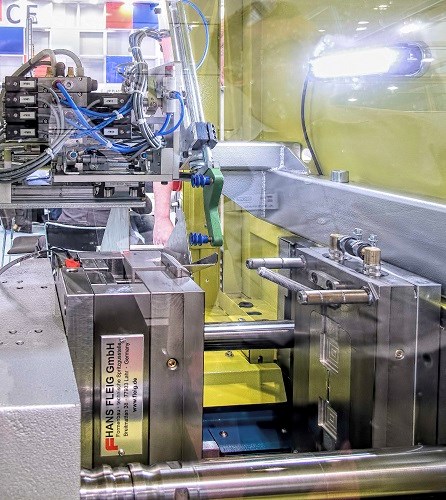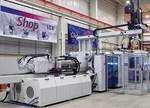Where Was 3D Printing at the Fakuma Show?
All over, and in a variety of roles.

Additive manufacturing, or 3D printing, appeared in various guises throughout October’s Fakuma 2015 show in Friedrichshafen, Germany:
• Arburg (U.S. office in Rocky Hill, Conn.) brought three of its Freeformer machines, the first to use standard molding pellets, to Fakuma. Two of them formed part of “Industry 4.0” exhibits of “personalized manufacturing” in which the Freeformers applied individualized decoration to injection molded parts. One new wrinkle was an automated cell in which a Freeformer was tended by a Kuka robot instead of a human operator.
Arburg officials noted in a Q&A session with the press that its 3-axis Freeformer model is meeting current demands of the market and there is little push from customers so far to commercialize a more expensive 5-axis version. More immediate development priorities, the officials said, were nitrided components to resist wear, a larger build envelope, and printing of high-temperature resins.
• While Arburg is the first plastics machinery company to offer its own 3D printer, Boy Machines (U.S. office in Exton, Pa.) announced at the show that it is offering a turnkey package with a Stratasys 3D printer for making plastic cavity inserts. Such tool inserts (which also appeared at multiple exhibits at NPE2015 in Orlando) are typically made of ABS and are said to last for up to 500 shots. Because there is no internal cooling for the inserts, Boy blew cold air over the mold face between cycles.
3D-printed ABS mold inserts were also shown at Fakuma by Hasco (U.S. office in Fletcher, N.C.) as prototyping accessories for its quick-change mold bases.
• Boy Machines showed another application of 3D printing in end-of-arm tooling for a sprue picker. KraussMaffei (U.S. office in Florence, Ky.) also showed 3D-printed EOAT on articulated six-axis and Cartesian three-axis robots, as well as a servo sprue picker, in three molding cells. KM noted that 3D printing allows the customer to make its own EOAT, to make it fast and lightweight and with optimized conformity to the shape of the part to be handled. (For more on 3D-printed EOAT, see Aug. ’14 Close Up.)
Related Content
-
Five Ways to Increase Productivity for Injection Molders
Faster setups, automation tools and proper training and support can go a long way.
-
ICIS Launches: Ask ICIS Generative AI Commodities Assistant
Said to be the first of its kind, this AI assistant will enhance access to ICIS’ intelligence and insights for the energy and chemical markets.
-
Scaling New Heights With Vertical Integration
Eden Manufacturing was founded on a vision of vertical integration, adding advanced injection molding capabilities to a base of precision moldmaking and more recently bringing Swiss-type machining capabilities in-house.
















